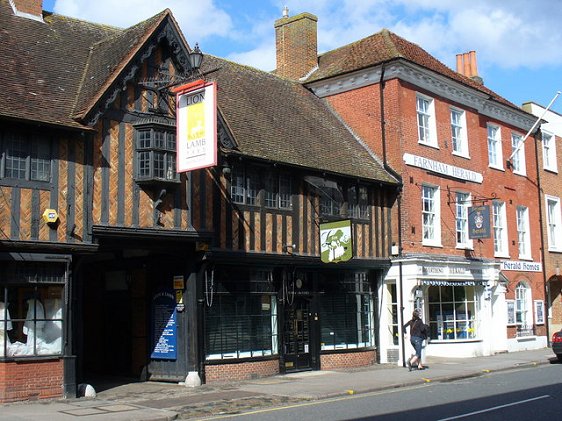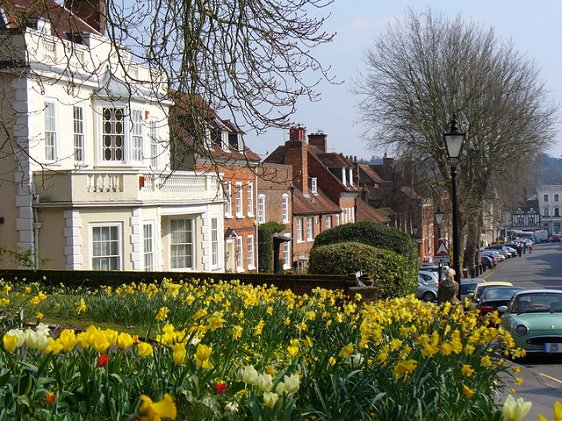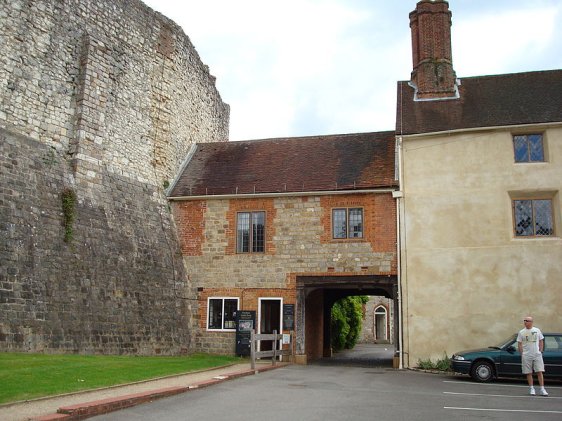 Farnham, Surrey, England: Source: https://commons.wikimedia.org/wiki/File:Lion_and_Lamb_Yard_Entrance_-_geograph.org.uk_-_746109.jpg
Farnham, Surrey, England: Source: https://commons.wikimedia.org/wiki/File:Lion_and_Lamb_Yard_Entrance_-_geograph.org.uk_-_746109.jpgAuthor: Colin Smith

Farnham is a town in Waverley district, on the west side of Surrey, England. Located about 67 km (42 mi) to the southwest of London, Farnharm has a population of about 39,000 people (2012 estimate).
Traces of human presence in Farnham indicate that the area has been inhabited for thousands of years, going back to the Paleolithic period. Remnants of pit dwellings from this period has been discovered. There is also a prehistoric trackway, called the Harrow Way, that passes through Farnham Park, providing proof that the area has been worked.
The availability of gault clay led to the Farnham area becoming a center for pottery during the Roman period. Kilns dating to AD 100 have been discovered here. The main pottery center in the area is at Alice Holt Forest.
Farnham got its name during the Anglo-Saxon period. In its earliest incarnation, it was listed as Fearnhamme in the Anglo-Saxon Chronicle. After Norman Conquest, the town was listed as Ferneham in the Domesday Book of 1086. In 1138, Henry de Blois, grandson of William the Conqueror, started work on Farnham Castle. Henry de Blois was also the Abbot of Glastonbury Abbey and Bishop of Winchester. He built Farnham Castle to provide accommodation for the Bishops of Winchester, who had to travel frequently between Winchester and London, and Farnham happened to be approximately midway between the two towns. The castle became a residence of the Bishops of Winchester for over 800 years.
 Castle Street, Farnham: Source: https://commons.wikimedia.org/wiki/File:Spring_in_Castle_Street_-_geograph.org.uk_-_384040.jpg
Castle Street, Farnham: Source: https://commons.wikimedia.org/wiki/File:Spring_in_Castle_Street_-_geograph.org.uk_-_384040.jpgAuthor: Colin Smith

The Black Death in 1348 shaved a third of the town's population. By the 17th century, the area was suffering from serious economic depression, compounded by heavy taxes by King Charles I. Thus when the English Civil War erupted, Farnham threw its support to the Parliamentarians.
Farnham was again flourishing in the late 18th and 19th centuries. It has the most profitable corn market in the country after London. The town also became a center for greenware pottery, wool and textile, and for processing flour and hops. A railway line was built to connect Farnham with London in 1848. This was the start of Farnham's evolution into a commuter town.
Today Farnham remains a market town. The main streets in town are West Street, The Borough and East Street. Major retail chains of shops and bookstores are represented here including Sainsbury's, Waterstone's, WH Smith, and Boots.
 Entrance to Farnham Castle: Source: https://commons.wikimedia.org/wiki/File:Farnham_Castle_1.jpg
Entrance to Farnham Castle: Source: https://commons.wikimedia.org/wiki/File:Farnham_Castle_1.jpgAuthor: SuzanneKn

Visiting Farnham
The fastest way to reach Farnham from London by road is to take the M3 motorway to Junction 4, then continue south on the A331 road. When it joins the A31 road, head west till you reach Farnham.Places of Interest in Farnham
- Alice Holt Forest: Former royal forest about 6.4 km to the south of Farnham.
- Farnham Castle: Castle built by Henri de Blois, grandson of William the Conqueror, in 1138.
- Moor Park House, Farnham: Country house, formerly called Compton Hall, set in some 60 acres of grounds. The house is a Grade II listed heritage building.
- Mother Ludlam's Cave: Cave in the sandstone cliff of the Wey Valley at Moor Park, subject to many local legends. Mother Ludlam is a white witch who lived in the cave.
- Waverley Abbey: Ruins of the first Cistercian abbey in England founded by William Giffard, Bishop of Winchester, in 1128.
 Latest updates on Penang Travel Tips
Latest updates on Penang Travel Tips
 Discover with Timothy YouTube Channel
Discover with Timothy YouTube Channel
 PG Food Channel
PG Food Channel
 Learn Penang Hokkien YouTube Channel
Learn Penang Hokkien YouTube Channel
 SojiMart Videos
SojiMart Videos
Latest from Discover with Timothy: Gurney Bay - what to see and do there
About this website

Hello and thanks for reading this page. My name is Timothy and my hobby is in describing places so that I can share the information with the general public. My website has become the go to site for a lot of people including students, teachers, journalists, etc. whenever they seek information on places, particularly those in Malaysia and Singapore. I have been doing this since 5 January 2003, for over twenty years already. You can read about me at Discover Timothy. By now I have compiled information on thousands of places, mostly in Peninsular Malaysia and Singapore, and I continue to add more almost every day. My goal is to describe every street in every town in Malaysia and Singapore.
Robbie's Roadmap
- Episode 1: Robbie's Journey to Financial Freedom
- Episode 2: Lost in America
- Episode 3: The Value of Money
- Episode 4: The Mentor
- Episode 5: The Thing that Makes Money
- Episode 6: The walk with a Billionaire
- Episode 7: The Financial Freedom Awakening
- Episode 8: Meet Mr Washington
- Episode 9: The Pizzeria Incident
Copyright © 2003-2024 Timothy Tye. All Rights Reserved.


 Go Back
Go Back